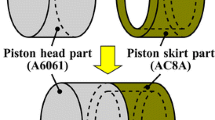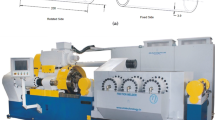Abstract
The friction-assisted solid state lap joining process of dissimilar metal pipes is proposed by joining copper (Cu) and aluminum (Al) pipes. The joining process is designed to have two successive stages. In the first stage, the Cu pipe rotating with a mandrel rotates against the inner surface of the Al pipe. In the first stage, the relative rotation between the Cu and Al pipes breaks the oxide layers on the contacting surfaces and increases the temperature at the interface. In the second stage, as the area of the contact surface between the Cu and Al pipes increases due to the linear motion of the mandrel; as the mandrel begins to rotate alone against the Cu pipe, which now becomes stationary to induce diffusion bonding between the Cu and Al pipes. The results of microstructural analysis and mechanical testing show that solid state lap joining between the Cu and Al pipes for a light-weight heat exchanging component is successfully achieved. The microstructure evolution suggests that grain refinement by recrystallization occurs in the joining region for both the Cu and Al sides.
Highlights
-
The performance of friction-assisted solid state lap joining between dissimilar pipes is identified through experiment
-
A custom-made pneumatic press device was designed to realize the suggested solid state joining method
-
The joint quality was confirmed by microstructure analysis and mechanical testing
-
Aluminum base metal fracture was observed during tensile test














Similar content being viewed by others
References
Okamura, H., & Aota, K. (2010). Joining of dissimilar materials with friction stir welding. Welding international, 18, 852–860.
Hirsch, J. (2014). Recent development in aluminium for automotive applications. Transactions of Nonferrous Metals Society of China, 24, 1995–2002.
Wang, T. (2020). A review of technologies for welding magnesium alloys to steels. International Journal of Precision Engineering and Manufacturing-Green Technology, 8, 1027–1042.
Celik, S., & Ersozlu, I. (2009). Investigation of the mechanical properties and microstructure of friction welded joints between AISI 4140 and AISI 1050 steels. Materials & Design, 30, 970–976.
Mercan, S., Aydin, S., & Özdemir, N. (2015). Effect of welding parameters on the fatigue properties of dissimilar AISI 2205–AISI 1020 joined by friction welding. International Journal of Fatigue, 81, 78–90.
Chen, N., Wang, H.-P., Wang, M., Carlson, B. E., & Sigler, D. R. (2019). Schedule and electrode design for resistance spot weld bonding Al to steels. Journal of Materials Processing Technology, 265, 158–172.
Peng, L., Xu, Z., & Lai, X. (2013). An investigation of electrical-assisted solid-state welding/bonding process for thin metallic sheets: Experiments and modeling. Proceedings of the Institution of Mechanical Engineers, Part B: Journal of Engineering Manufacture, 228, 582–594.
Galvão, I., Oliveira, J. C., Loureiro, A., & Rodrigues, D. M. (2012). Formation and distribution of brittle structures in friction stir welding of aluminium and copper: Influence of shoulder geometry. Intermetallics, 22, 122–128.
Xue, P., Xiao, B. L., Ni, D. R., & Ma, Z. Y. (2010). Enhanced mechanical properties of friction stir welded dissimilar Al–Cu joint by intermetallic compounds. Materials Science Engineering A, 527, 5723–5727.
Tan, C. W., Jiang, Z. G., Li, L. Q., Chen, Y. B., & Chen, X. Y. (2013). Microstructural evolution and mechanical properties of dissimilar Al–Cu joints produced by friction stir welding. Materials & Design, 51, 466–473.
Barekatain, H., Kazeminezhad, M., & Kokabi, A. H. (2013). Microstructure and mechanical properties in dissimilar butt friction stir welding of severely plastic deformed aluminum AA1050 and commercially pure copper sheets. Journal of Materials Science & Technology, 30, 826–834.
Galvão, I., Leitão, C., Loureiro, A., & Rodrigues, D. M. (2012). Study of the welding conditions during similar and dissimilar aluminium and copper welding based on torque sensitivity analysis. Materials & Design, 42, 259–264.
Saeid, T., Abdollah-zadeh, A., & Sazgari, B. (2010). Weldability and mechanical properties of dissimilar aluminum–copper lap joints made by friction stir welding. Journal of alloys and compounds, 490, 652–655.
Elrefaey, A., Takahashi, M., & Ikeuch, K. (2005). Perliminary investigation of friction stir welding aluminium/copper lap joints. Weld World, 49, 93–101.
Xue, P., Xiao, B. L., Wang, D., & Ma, Z. Y. (2011). Achieving high property friction stir welded aluminium/copper lap joint at low heat input. Science and Technology of Welding and Joining, 16, 657–661.
Akbari, M., Abdi Behnagh, R., & Dadvand, A. (2012). Effect of materials position on friction stir lap welding of Al to Cu. Science and Technology of Welding and Joining, 17, 581–588.
Bisadi, H., Tavakoli, A., Tour Sangsaraki, M., & Tour Sangsaraki, K. (2013). The influences of rotational and welding speeds on microstructures and mechanical properties of friction stir welded Al5083 and commercially pure copper sheets lap joints. Materials & Design, 43, 80–88.
Galvão, I., Verdera, D., Gesto, D., Loureiro, A., & Rodrigues, D. M. (2013). Influence of aluminium alloy type on dissimilar friction stir lap welding of aluminium to copper. Journal of Materials Processing Technology, 213, 1920–1928.
Kuang, B., Shen, Y., Chen, W., Yao, X., Xu, H., Gao, J., et al. (2015). The dissimilar friction stir lap welding of 1A99 Al to pure Cu using Zn as filler metal with “pinless” tool configuration. Materials & Design, 68, 54–62.
Zhang, J., Shen, Y., Yao, X., Xu, H., & Li, B. (2014). Investigation on dissimilar underwater friction stir lap welding of 6061–T6 aluminum alloy to pure copper. Materials & Design, 64, 74–80.
Oh-ishi, K., Edalati, K., Kim, H. S. (2013). High-pressure torsion for enhanced atomic diffusion and promoting sold-state reactions in the aluminum-copper system. Acta Materialia, 61, 3482–3489.
Sato, T., Kawauchi, K., & Muto, A. (2010). Magnetic impulse welding of Al tube and Cu tube with various core materials. Welding Internetional, 12, 619–626.
Xia, T., Liu, X., Li, Q., & Yu, W. (2012). The brazing of copper pipe and aluminum pipe based on the 4R. Advanced materials research, 476-478, 721–725.
Kim, G.-W. (2022). Realization of enhanced mechanical properties of solid-state welded Ti alloy with commercial purity. International Journal of Precision Engineering and Manufacturing, 23, 471–477 (2022).
Muralimohan, C. H., & Haribabu, S. (2014). Evaluation of microstructures and mechanical properties of dissimilar materials by friction welding, Procedia. Materials Science, 5, 1107–1113.
Cheepu, M., & Muthupandi, V. (2018). Improving mechanical properties of dissimilar material friction welds. Applied Mechanics and Materials, 877, 157–162.
Bergmann, J. P., & Petzoldt, F. (2013). Solid-state welding of Al to Cu. Welding in the World, 57, 541–550.
Sahin, M. (2010). Joining of aluminium and copper materials with friction welding. The International Journal of Advanced Manufacturing Technology, 49, 527–534.
Hou, W., Oheil, M., Shen, Z., & Shen, Y. (2020). Enhanced strength and ductility in dissimilar friction stir butt welded Al/Cu joints by addition of a cold-spray Ni interlayer. Journal of Manufacturing Processes, 60, 573–577.
Wei, Y., Li, J., & Xiong, J. (2016). Investigation of interdiffusion and intermetallic compounds in Al–Cu joint produced by continuous drive friction welding, Engineering Science and Technology, an International Journal, 19, 90–95.
Wang, T., Shukla, S., Nene, S. S., Frank, M., & Wheeler, R. W. (2018). Towards obtaining sound butt joint between metallurgically immiscible pure Cu and stainless steel through friction stir welding. Metallurgical and Materials Transactions A, 49, 2578–2582.
Wang, T., Komarasamy, M., Liu, K., & Mishra, R. S. (2018). Friction stir butt welding of strain-hardened aluminum alloy with high strength steel. Materials Science and Engineering: A, 8, 85–89.
INDUSTRIAL HEATING, Daniel H. Herring, Annealing Copper and Copper Alloys, Available online: https://www.industrialheating.com/ (accessed on 26 August 2009)
Zhao, Y., Li, L., Zepeng, Lu., Teng, G., Liu, S., Zhiliu, Hu., & He, A. (2021). The effect of annealing temperature on the recrystallization and mechanical properties of severe plastic deformed commercial pure aluminum during ultra-fast annealing. Materials Research Express, Express, 8, 046515.
Zhang, S., Gao, K., Hong, S.-T., Ahn, H., Choi, Y., Lee, S., & Han, H. N. (2021). Electrically assisted solid state lap joining of dissimilar steel S45C and Al 6061–T6 alloy. Journal of Materials Research and Technology, 12, 271–282.
Acknowledgements
This work was supported by the National Research Foundation of Korea (NRF) grant funded by the Korea government (MSIT) (No. 2020R1A5A6017701). This work was supported by the National Research Foundation of Korea (NRF) grant funded by the Korea government (MSIT) (No. 2019R1A2C2009939, 2021R1A2C3005096).
Author information
Authors and Affiliations
Contributions
All authors read and approved the final manuscript.
Corresponding author
Additional information
Publisher's Note
Springer Nature remains neutral with regard to jurisdictional claims in published maps and institutional affiliations.
Rights and permissions
Springer Nature or its licensor (e.g. a society or other partner) holds exclusive rights to this article under a publishing agreement with the author(s) or other rightsholder(s); author self-archiving of the accepted manuscript version of this article is solely governed by the terms of such publishing agreement and applicable law.
About this article
Cite this article
Kang, JW., Zhang, S., Bui Thi, TA. et al. Friction-Assisted Dissimilar Solid State Lap Joining of Aluminum and Copper Pipes. Int. J. Precis. Eng. Manuf. 24, 199–208 (2023). https://doi.org/10.1007/s12541-022-00745-9
Received:
Revised:
Accepted:
Published:
Issue Date:
DOI: https://doi.org/10.1007/s12541-022-00745-9




